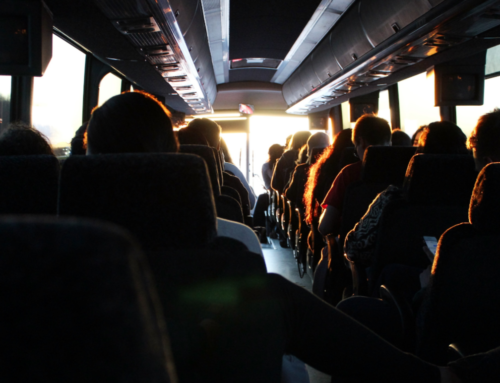Benefits of Traveling on a Bus
Traveling on a bus offers numerous benefits, which contribute to its popularity as a mode of transportation for various individuals. Here are 50 benefits of traveling on a bus:
- Cost-effectiveness: Buses are often more affordable than other modes of transportation like plane
Buses are generally more cost-effective than flying or trains.
- Eco-friendly: Buses are more environmentally friendly, producing fewer emissions per passenger.
- Comfortable seating: Many buses have comfortable seats with ample legroom.
- Scenic views: Buses often take routes that showcase beautiful landscapes and scenic views.
- Social interactions: You can meet and interact with diverse people during your bus journey.
- Relaxation: Sitting back and enjoying the ride can be quite relaxing.
- No driving stress: You don’t have to worry about navigating traffic or parking.
- Accessibility: Buses can reach remote areas that other forms of transportation might not.
- Efficient travel routes: Buses may offer direct routes to your destination, minimizing transfers.
- Large luggage capacity: Buses typically have ample space for luggage and other belongings.
- Wi-Fi and power outlets: Some modern buses offer Wi-Fi and charging ports for electronic devices.
- No baggage fees: Unlike airlines, buses usually do not charge extra for luggage.
- Safety: Buses are statistically safer than cars in terms of accidents per mile traveled.
- Accessibility for all: Buses are designed to accommodate passengers with disabilities.
- Convenient schedules: Buses often run on fixed schedules, making planning easier.
- Flexibility: Bus tickets are generally refundable or can be rescheduled with ease.
- Multi-stop trips: Buses allow you to explore multiple destinations on a single ticket.
- No security checks: You don’t have to go through rigorous security checks as at airports.
- Entertainment options: Some buses offer onboard entertainment to pass the time.
- Opportunity to read or work: You can read a book or get some work done during the journey.
- Reduced road congestion: Buses can help reduce traffic congestion on busy routes.
- Dedicated bus lanes: In some cities, buses have dedicated lanes, making them faster than cars.
- Cost-effective for groups: Group discounts are common for bus travel.
- Availability: Buses operate on various routes, making them widely accessible.
- Timeliness: Buses often adhere to strict schedules, reducing waiting times.
- Onboard restrooms: Longer bus journeys may have onboard restrooms for convenience.
- No baggage claim: Upon arrival, your luggage is readily accessible, avoiding the need to wait.
- Door-to-door service: Some bus companies offer pick-up and drop-off services.
- Lower carbon footprint: Buses emit fewer greenhouse gases per passenger compared to cars.
- Community engagement: Buses can help foster a sense of community among travelers.
- Local exploration: Buses allow you to experience local culture up close.
- No hidden fees: Bus fares are generally straightforward without hidden charges.
- Group travel experience: Sharing a bus journey with others can be fun and enjoyable.
- Extra legroom: Some buses offer more legroom than planes or trains.
- Travel insurance: Some bus tickets come with complimentary travel insurance.
- Flexibility to change plans: You can easily alter your travel dates with most bus tickets.
- No baggage weight limits: Unlike airlines, buses don’t have strict baggage weight restrictions.
- Accessibility to remote attractions: Buses can take you to off-the-beaten-path destinations.
- Overnight options: Sleeper buses offer overnight travel, saving you on accommodation costs.
- Exercise during stops: During rest breaks, you can stretch and move around.
- Cultural exposure: Interacting with locals and fellow travelers can enhance cultural understanding.
- Kid-friendly: Buses are family-friendly and suitable for traveling with children.
- Reduced travel anxiety: For some, bus travel is less anxiety-inducing than other modes.
- Better for short distances: Buses are efficient for short to medium-distance trips.
- Reduced pollution: Choosing buses over personal cars reduces air pollution.
- Support local economies: Bus travel often supports local transportation services and economies.
- Fewer travel restrictions: Unlike flights, buses have fewer security and baggage restrictions.
- Supportive community: Many bus travelers have positive experiences and form a supportive community.
- Unique experiences: Bus travel offers a distinctive experience compared to other modes.
- Reconnect with nature: Long bus journeys allow you to appreciate the beauty of nature outside your window.
- These benefits demonstrate that bus travel can be an enjoyable, cost-effective, and sustainable way to explore various destinations.
For those looking for a unique and memorable travel experience, bus travel is an excellent choice. Not only does it provide the opportunity to learn about different cultures and landscapes, but it also allows travelers to meet new people and develop relationships with fellow travelers. From cost-effectiveness and convenience to scenic views and onboard amenities, bus travel has a lot to offer. Whether you’re looking for a short trip or a longer journey, bus travel can provide a great way to explore and experience the world.
For those looking to reduce their carbon footprint, bus travel is an ideal choice. By using buses, travelers can reduce their reliance on cars and planes, which are two of the biggest contributors to global warming and climate change. Moreover, bus travel is an economical way to get around, with tickets typically cheaper than those of other transportation options. Therefore, choosing bus travel can help travelers save money while also doing their part to protect the environment.
You generally do not need an ID to travel by bus. Unlike air travel, bus companies typically do not require passengers to present identification before boarding. However, it is always a good idea to carry a form of identification with you when traveling, regardless of the mode of transportation. This can be helpful in case of any unforeseen circumstances or if you need to provide identification for any reason during your journey.
Travel bus costs can vary depending on various factors such as the distance of the journey, the duration of the trip, the type of bus, and the amenities provided. Generally, the cost of a travel bus ticket is more affordable compared to other modes of transportation like flying or taking a train. To get specific information about travel bus costs, it is recommended to check with the bus travel agency near you or visit their website to find accurate and up-to-date pricing details.
The provision of free bus travel for students varies significantly depending on the country, region, and local transportation policies. Some areas offer free or heavily discounted bus travel for students, while others do not.
In some places, students may receive free bus passes or reduced-fare cards issued by their educational institutions or local government authorities. These passes typically allow students to use public buses to travel to and from school or college without paying regular fares.
However, in many regions, students are required to pay regular fares unless they qualify for other discounts, such as reduced fares for youth or students.
It’s essential to check with the specific transportation authorities or educational institutions in your area to understand the available options and any potential discounts for student bus travel. Policies can change over time, and different cities or countries may have different approaches to providing public transportation benefits to students.
The availability of bathrooms on travel buses can vary depending on the type of bus and the length of the journey. Here are the common types of buses and their bathroom arrangements:
- Coach Buses: Most long-distance or intercity coach buses, especially those designed for extended travel, are equipped with onboard restrooms. These restrooms are typically small and located at the back of the bus.
- Sleeper Buses: Sleeper buses, which are designed for overnight journeys, often have onboard restrooms as well. These buses feature reclining seats that convert into beds, and the restroom facilities are usually compact but functional.
- City Buses: Regular city buses that operate within urban areas usually do not have onboard restrooms. These buses are meant for shorter trips, and passengers are expected to use restroom facilities at bus stops or their destination.
- School Buses: Traditional school buses used for transporting students to and from schools generally do not have restrooms.
- Shuttle Buses: Shuttle buses used for airport transfers, hotel shuttles, or short-distance transportation typically do not have restrooms either.
It’s important to note that while many long-distance buses have onboard restrooms, the facilities may not be as spacious or well-equipped as those found in other forms of transportation. Additionally, some regional or short-distance bus services may not offer restroom facilities onboard, but they are likely to make stops at rest areas or service stations during longer journeys to provide passengers with restroom breaks.







